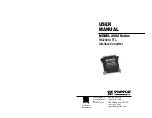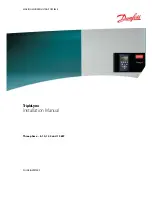
10
1)
DVB-T: modulating standard; XX.XXX MHz: the current output frequency; 1080i: video
resolution of signal source; X.XX Mbps: the current encoding bit rate
2)
Alarm Status: For example, if the signals lose, it will give alarm and display error type
under this menu. For example:
Video Not Lock
3)
Uptime: It displays the working time duration of the device. It times upon power on.
4)
Encoder Parameters: User can enter the items respectively to set Encoder parameters.
Interface:
To select the input port (Auto or HDMI or CVBS), the device will process the
signal from the corresponding interface.
Video in Status
: User can view the video status
under this menu.
Resolution
: signal source resolution, read-only.
Video Bit rate
: adjust in
the range of 1.000~18.000 Mbps.
Audio Bit rate:
Select audio bit rate among 64, 96, 128,
192, 256, 320kbps.
5)
Stream: User can view or adjust TSID (Transport Stream ID), ONID (Original Network ID),
Network ID, Network Name, Program number, LCN (Logical channel number) and etc for
the output TS after enter this menu.
NIT: (Network Information Table) NIT table is a very important table for describing the
network and TS. User can enter the submenus displayed and edit the values or select modes.
6)
Country: User can choose country under this menu. There are five options Default,
Australia, New Zealand, Sweden and Italy. If user chooses Default, modulating parameters
need to be set manually through advanced configuration. If choose other four, user do not
need to set RF frequency, Bandwidth, Constellation, FEC, FFT, Guard interval and RF Level.
It will configure automatically according to the Country and Channel. It is a shortcut.
7)
Channel: User can choose Channel under this submenu.
8)
Bit Rate: User can read the current modulating bit rate and the maximum bit rate
9
) RF
Frequency: Adjust it at range of 142.5 MHz to 946MHz. Set it according your regional
situation or inquire your local services.
10)
Bandwidth: choose between 6M, 7M and 8M.
11)
Constellation: DVB-T modulator contains 3 constellation modes – 64 QAM, QPSK and 16
QAM.
12)
FEC: Forward Error Correction rate. It contains 1/2, 2/3, 3/4, 5/6 and 7/8.
13)
FFT (Transmission Mode): Select between 2K and 8K.
14)
Guard Interval: Select among 1/32, 1/16, 1/8 and 1/4.
15)
RF Level: Adjust it at range of -14~ +6dBm.
































